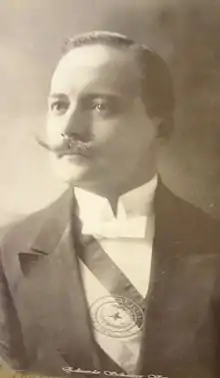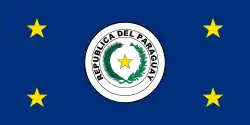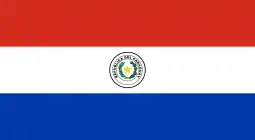Eduardo Schaerer
Eduardo Schaerer Vera y Aragón (December 2, 1873 in Caazapá – November 12, 1941 in Buenos Aires) was a Swiss-Paraguayan businessman, publisher, and Liberal politician. He served as President of the Republic of Paraguay for the constitutional term 1912–1916.
Eduardo Schaerer | |
|---|---|
 | |
| 25th President of Paraguay | |
| In office August 15, 1912 – August 15, 1916 | |
| Vice President | Pedro Bobadilla |
| Preceded by | Emiliano González Navero |
| Succeeded by | Manuel Franco |
| Personal details | |
| Born | December 2, 1873 Caazapá |
| Died | November 12, 1941 (aged 67) Buenos Aires |
| Nationality | Paraguayan |
| Political party | Liberal Party |
| Spouse(s) | Silvia Matilde Heiseke |
Schaerer was succeeded by Dr. Manuel Franco on August 15, 1916. Ex-president Schaerer continued in public service as a senator in 1921 and founded the newspaper La Tribuna (The Tribune) in 1925.
Schaerer was born in Caazapá, on December 2, 1873 to Mr. Santiago Schaerer and Mrs. Elizabeth Vera y Aragon. His father was a notable Swiss colonizer (from Vordemwald, Aargau), and the special character that distinguished Schaerer was inherited from him. Schaerer was married to Mrs. Matilde Heisecke (Christian Heisecke daughter, a German diplomatic and consul of the Austro-Hungarian Empire), she had seven children with him, one that deserves to be mentioned, was Arturo Schaerer Heisecke, director of the newspaper La Tribuna after his father, and received the Maria Moors Cabot Prize, journalism award of the Columbia University, in 1953.
His life
His elementary education was conducted in his hometown, and the high school level, in the National High School of the Capital. From a young age he went into business, politics and journalism. He was one of the founders of the newspaper " El Diario " with Gualberto Cardús Adolfo Huerta and Adolfo Riquelme, and founder of La Tribuna (Paraguay), newspaper of his single property that was for over half a century the head of the national press. He died in Buenos Aires on November 12, 1941.
His government
The name of Eduardo Schaerer had been spoken repeatedly in the city, as the only one capable of guiding the difficult circumstances that became apparent in the future. He assumed the presidency of the Republic from August 15, 1912 until August 15, 1916. His cabinet was composed of: Eusebio Ayala, Foreign Affairs; Manuel Gondra, War and Navy; Félix Paiva, Justice, Culture and Public Instruction; Gerónimo Zubizarreta, Finances and José P. Montero, Interior. There were some changes later: Gondra went to the chancery, Colonel Patricio A. Escobar War and Navy; Eusebio Ayala to Treasury, Culture and Public Instruction and Belisario Rivarola to Justice.
Works
With his government a period of political stability and economic prosperity that lasted nearly a decade began. In 1912, Dr. Manuel Franco was appointed rector of the University. In 1913 the resignation of Doctor Teodosio González was accepted to his chair of Criminal Law and Mr. Simeon Carísimo was director of the National School of Villarrica, where Francisco Ruffinellis began to exert the chair of Geography.
It began operating the C.A.L.T. (Predecessor of the A.N.D.E.), counting with the first electric lighting system in the country, and the first telephone system and electric tram.
At the beginning of his administration, Paraguay had 180 km of railways that reached the city of Villarrica. In 1916 at the end of his government they counted nearly 700 km of railways. In 1913 the railroad reaches the city of Encarnacióm and assembled with the rail line enabling the city of Posadas (Argentina) allowing the fast arrival of Paraguayan products to the Atlantic Ocean. Also the construction of a railway network began in the Department of Concepción that should have connected with the Brazilian system and the new railway company Carlos Casado in the Chaco. But above all it must be mentioned the construction of the branch to Abaí that should have connected with Brazil and get way out to the ocean for export products. Manuel gondra with his ministers and Eusebio Ayala was the precursor to the development of this country and a new geopolitical concept for Paraguay. In this regard also, in 1915 he was presented the first study for the hydroelectric development of the Saltos del Guaira, precursor idea of the current Itaipu.
In urban, during his tenure a new Municipal Organic Law, in Asuncion numerous public works began a period of major urban transformations were performed took effect.
During his administration, a new Municipal Organic Law came into force. There were carried out several public works, as improving public parks, street paving, demolition and relocation to the old central market, demolition of the former House of Governors, for opening a Centennial Walk.
In the educational field, by decree it included the learning of English in the secondary school curriculum. Villarrica, Encarnacion, Pillar, also in Barrero Grande: the first rural normal schools in three of the historic villas were created.
It was the first Paraguayan president since Carlos Antonio Lopez sent scholarship to Europe and United States. During his government sent more than 200 Paraguayans to important European universities, among which we can mention promising men like Silvio Pettirossi, Bruno Guggiari Nicolas Sarubbi, Tomas Romero Pereira, Pedro Ciancio, Pedro Calunga, Anselmo Jover Peralta and many others.
Defense regarding the aid was promoted to veterans and June 23, 1915 the Military Academy, which would be essential for the formation of a high-level military class would defend the Chaco years later was created.
In 1913 during his tenure, the former American President Theodore Roosevelt visited Paraguay.
In the Judiciary order Dr. Cecilio Báez was appointed to the Superior Court, Federico Chaves was appointed prosecutor of crime and Luis Ruffinelli defender of poor inmates in 1914, and in August 1915 Dr. Enrique Bordenave assumed the general secretariat of the presidency. In the same year he adopted the curriculum of the School of Commerce and it was expanded the law of regulation of secondary and higher education.
The cultural situation of the country received a motivation encouraged by Don Manuel Gondra, the "thinking man", one of the most important intellectual men of that time. Schaerer signed the appointments of poets and artists, as Rubén Darío, Narciso Colmán, Leopoldo Jimenez Ramos, Eloy Fariña Núñez, Delfín Chamorro, Manuel Ortiz Guerrero, Modesto Delgado Rodas, Justo Pastor, Federico Garcia; among others.
One of the most significant things was the continuing numbers of laws, beginning with the year 1913. Theses are distinguished: the permission to rid the public post office of San Lorenzo Ñu Guazú in (1912); one in which is resolved the acquisition of materials for the Museum of Natural History in (1913) and another one that set the continuation of the reconstruction work of the Oratory (Pantheon of the Heroes).
On January 1, 1915 people in Asuncion were awakened in early hours with a terrifying shooting. The bullets came from an uprising led by Dr. Freire Gomes Esteves and his brother, Luis Freire Esteves. As Colonel Manuel J. Duarte was absent, the military commanders were a captain, a lieutenant and a sergeant. They captured the president but the attempt failed.
Schaerer was the first civilian President who managed to complete his mandate without conspiracies or military uprisings.
Political biography
In the year 1904 he was part of the main civilians leaders of the liberal insurgency, he acted in Our Lady of Pilar, Ñeembucú. Schaerer emerged as one of the signatories of the manifesto read “to the People”, on July 4, 1908, with which the "radical" group tried to justify the uprising that was planned by mayor Albino Jara. He was mayor of the municipality of Asunción between July 5, 1908 and January 17, 1911. He also served as Director of Customs, Minister of the Interior (1912) and Senator (1921). On August 7 of that year, he signed the invitation to participate in the assembly of that style, which took place on the 15th at the National Theater, which at that time intended to "constitute a large ruling party."
Schaerer was the first civilian president who managed to finish its mandate without any hitting or military uprisings. He had an extremely important role in strengthening of institutions and the development of civil leader Paraguay and is remembered as one of the great builders of the Guarani nation.
He served as the President of the Senate in 1919-1920.[1]
References
- (in Spanish) Biography at the Wayback Machine (archived October 26, 2004) (Presidency of the Republic of Paraguay) (in Spanish)
- "Paraguay's Former President Dies in Exile at 66." The New York Times 13 November 1941: 28.
| Political offices | ||
|---|---|---|
| Preceded by Pedro P. Peña |
President of Paraguay 1912–1916 |
Succeeded by Manuel Franco |

